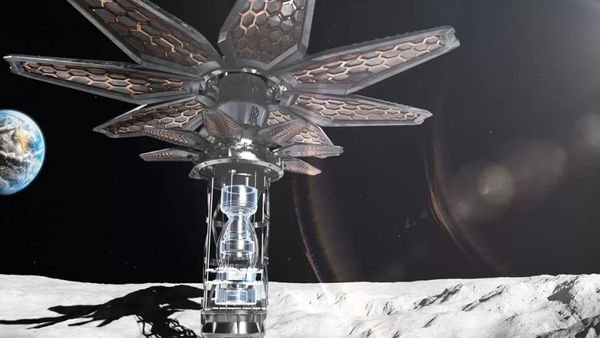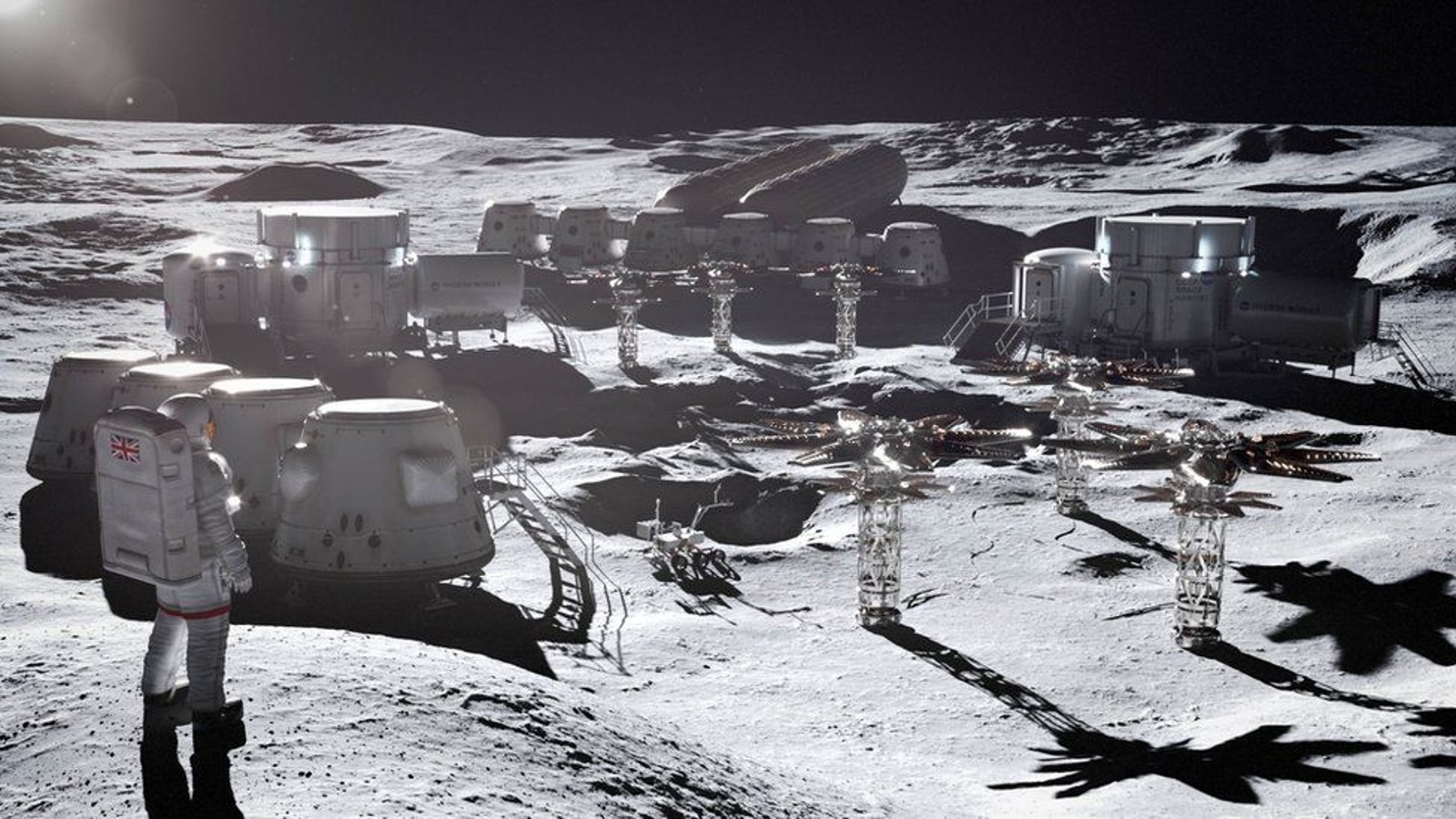New poppy seed-sized fuel pellets could power nuclear reactors on the moon
Scientists have developed a nuclear fuel source no larger than a seed, which NASA will test for use in future moon missions.

Scientists in the U.K. have created mini, seed-sized nuclear fuel cells that could power futuristic flower-shaped reactors on the moon as soon as 2030.
The tiny new fuel cells, developed by researchers at the Nuclear Futures Institute at Bangor University in Wales, are roughly the size of poppy seeds, which are around 0.04 inch (1 millimeter) across. The mini pellets are a type of tri-structural isotropic particle (TRISO) fuel, which is made from uranium, carbon and oxygen surrounded by a hard, ceramic-like shell. The cells are much more durable and efficient than traditional nuclear fuels, which makes them perfect for space exploration.
The fuel cells are designed to power the Space Flower Moon Micro Reactor, a conceptual car-sized fusion reactor designed by Rolls-Royce. Funding for the reactor was secured in early March, and the design is a leading candidate to power future moon bases as a part of NASA's Artemis program, which aims to establish a permanent base on the moon by 2030. Researchers think one of the durable pellets could power a single reactor for up to 15 years.
The fuel cells have now been sent to NASA for testing, which will simulate how the nuclear pellets deal with the simulated forces of a rocket launch and whether they are as efficient as the researchers claim, according to the BBC.
Related: Rolls-Royce gets funding to develop miniature nuclear reactor for moon base

Reliable power sources will be crucial for future moon bases because solar power cannot be relied upon at night, when temperatures plummet below minus 200 degrees Fahrenheit (minus 129 degrees Celsius) and vast amounts of energy will be needed to heat living quarters and vital infrastructure.
"On the moon and on planetary bodies that have day and night, we can no longer rely on the Sun for energy and therefore must design systems such as the small micro-reactor to sustain life," project researcher Simon Middleburgh, a nuclear materials expert at Bangor University, said in a statement.
Get the Space.com Newsletter
Breaking space news, the latest updates on rocket launches, skywatching events and more!
Nuclear reactors are the only current viable option for creating a reliable power source on such a short timescale, Middleburgh said. However, "the fuel must be extremely robust and survive the forces of launch and then be dependable for many years," he added.
The shells of TRISO fuels withstand corrosion, oxidation and high temperatures, and prevent radiation from leaking from the fuel, all of which may arise in space, according to the U.S. Department of Energy.
In addition to being robust enough to survive the journey to the moon, a main attraction of TRISO fuels is that they are extremely small, which makes them much more cost-effective to launch into space.
Although the mini reactor is designed primarily for space exploration, it could also provide a temporary source of reliable energy in areas affected by natural disasters such as earthquakes, tsunamis and tropical storms, the researchers said.
NASA isn't the only entity with its eyes on the moon. On Aug. 23, India's Chandrayaan-3 spacecraft landed near the moon's south pole in search of resources for a future lunar base. And in 2021, China and Russia announced plans to develop a joint base on the moon, although this project has suffered a recent setback after Russia's Luna 25 lander crash-landed on the moon last month.
Join our Space Forums to keep talking space on the latest missions, night sky and more! And if you have a news tip, correction or comment, let us know at: community@space.com.

Harry is a U.K.-based staff writer at Live Science. He studied Marine Biology at the University of Exeter (Penryn campus) and after graduating started his own blog site "Marine Madness," which he continues to run with other ocean enthusiasts. He is also interested in evolution, climate change, robots, space exploration, environmental conservation and anything that's been fossilized. When not at work he can be found watching sci-fi films, playing old Pokemon games or running (probably slower than he'd like).
-
24launch TO BE CLEAR, this is a fission reactor, not a fusion reactor, as the article claims.Reply
No doubt we will one day utilize fusion reactors for our future energy needs but we are still decades away from that being a reality (both practical and actual).
Still, Rolls-Royce is doing some pretty amazing work with just modest funding, scaling this down to something that's on a practical scale to launch and operate on the Moon and other planetary bodies, as well as large strides in efficiency - converting the resulting reactionary heat into useable energy. -
Unclear Engineer The article is very misleading in that it seems to imply that only one tiny particle makes a reactor. That is not correct - it takes a lot of these particles mixed into something like a stack of graphite blocks, or perhaps loose inside a pebble bed, to support a nuclear fission chain reaction.Reply
These fuel particles are not a new concept. The Fort St.Vrain nuclear power reactor in the U.S. was built and operated with these fuel particles. (see https://en.wikipedia.org/wiki/Fort_Saint_Vrain_Nuclear_Power_Plant ) Gulf General Atomic designed it, The fuel TRISO particles are contained in graphite blocks that have cooling holes through them, and are stacked inside a containment vessel that is filled with helium for collant. The hot helium is circulated through steam generators to make the steam to run turbines to turn generators to make electric power.
The recent work really only explores changes to the materials used in the fuel particles to make them even more resilient to high temperatures.
The attractive attributes of these particles is that they can operate at much higher temperatures than metallic fuel elements, so they can produce much more efficient nuclear reactors (~40% thermal efficiency). Although they do not leak fission products, but they do not capture the ionizing radiation emitted by the fission process or the radioactive decay of the fission products. So shielding is required if personnel will ever be in the vicinity once the reactor has been run at power, even when it is subsequently shut down.
These fuel pellets are designed to not be recycled, so they would be disposed in geologic repositories here on Earth for ground based nuclear power plants. The ceramic outer layers of these pellets are designed to not degrade like metallic fuel rods degrade, so they would not be leaking radioactive contaminants into the environment even after being buried in a nuclear waste repository that failed and was flooded with water some time in the distant future.
For space colonies, these types of reactors make good sense. They are efficient and can be made relatively light in weight. They do not require a lot of maintenance.










